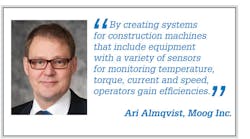According to McKinsey & Company, most large construction projects run over budget and take 20% longer to complete than planned. And the National Center for Construction Education and Research (NCCER) says there is a need for more than 600,000 heavy equipment operators across the United States through December 2022. In other words, construction can be expensive and demanding work for workers and their machines.
For example, most construction equipment runs all day long, even when an operator is waiting between tasks. That translates into greater emissions and use of fuel, since, even when idling, a diesel engine turns a torque converter and pump. Introducing zero-emission construction equipment may be a solution for some of the industry’s challenges. Countries like Norway and companies like CASE Construction Equipment and Bobcat Company are among those aiming for zero-emission construction sites.
As recently as last year, news from Oslo touted the first construction project where electric-battery-powered equipment ruled the job site. In Las Vegas last March, CASE unveiled its electric backhoe, which was an industry first. And Bobcat, with its model T76e compact track loader, has unleashed the world’s first all-electric compact track loader.
Electric-powered vehicles like these stop the moment an operator completes a function, so there’s no energy lost. There’s also a reduction in noise. That means better communication between workers and a remarkable improvement in the audible environment for work sites adjacent to communities.
Electric construction equipment also spells lower operating costs. CASE, for example, says its 580 EV backhoe will save an owner as much as 90% in annual vehicle, fuel and maintenance costs. By comparison, Equipment World magazine estimates a John Deere Model 310SJ backhoe-loader owned for four years and run approximately 900 hours per year would rack up preventative maintenance costs of $1,655 per year and $6.30 of diesel fuel per hour.
What’s Driving Adoption?
A driver behind the development and adoption of electric construction machines is battery technology. According to BloombergNEF, an increase in lithium-ion battery production over the last 10 years has helped prices plunge 85%, which has made electric vehicles commercially viable. Lithium-ion batteries enable longer operational time (up to eight hours) for electric construction vehicles and the ability to fully recharge some of these vehicles in eight hours.
Our contribution toward developing electric and zero-emission construction vehicles began two years ago by partnering with companies like Bobcat, CASE and Green Machine to provide the actuation, machine controls and electric drive train solution called WhisperDrive. By providing software, electronics to drive and control motors, cabling, gearboxes and machine controls, we helped Green Machine—which develops pack systems to replace lead-acid batteries and fossil fuel—and Bobcat produce its T550 compact track loader demonstrator and later its T76e prototype. Next, we began working on the CASE 580 EV backhoe. And we’re now working on a variety of small excavators.
The Bobcat T550 track loader we helped develop is fully electric, so there are no hydraulic hoses or oils to maintain. With zero emissions, the T550 also opens the possibility for construction workers to bring the machine inside a building. For the 580 EV, we teamed up with CASE to develop a pump drive unit and traction system along with sensors and controllers that electronically control the backhoe’s traction; the movements for the loader and excavation are hydraulic.
Cloud-Based Digital Machines
In spite of a focus on electric-powered innovation, machines with hydraulic movement also offer the possibility for incorporating intelligent designs. In the future, with the right mix of sensors, controllers, valves, actuators and interfaces, a machine designer could equip a construction vehicle that helps its operator by automatically recognizing no-dig zones, preventing a backhoe from digging below a certain depth or adjusting the backhoe-loader’s controls to maintain a pre-determined grade.
With all that’s possible, it’s remarkable how satisfied traditional machine operators continue to be with their vehicle’s limitations and performance. We know of machine manufacturers and owners who have spent years tuning and adjusting their equipment to achieve what operators feel is the perfect touch. Like tuning a classic car by tinkering with the engine controls and maybe changing the camshaft, mechanics tune a construction vehicle’s hydraulic valves or change parts on the joystick in the cab.
At our facility, we’ve demonstrated how the right combination of controls and electronics allow traditional machine owners to digitally tune their equipment, achieving in days what some equipment owners invest years to accomplish by mechanical adjustments.
The benefit of digitally tuning a construction vehicle is that owners can create operator-specific settings for each person who runs the equipment. The use of haptics is one way to make it easier for an operator to enhance, or run, a piece of equipment because the machine’s controls simultaneously exchange information between the vehicle and operator, providing a more precise feel. Haptics, which comes from the Greek word “haptikos,” means a sense of touch. If you tap an app on your mobile device, the vibration or sensation you feel is a kind of haptics.
This sense of feel might not be as important for a veteran equipment operator. But as noted above, the construction industry has an increasing number of heavy equipment operator roles to fill. Making equipment easier to operate offers a possible way to fill these jobs with younger workers who gravitate toward new technology and gaming.
The construction industry can greatly benefit from connectivity and digitally enabled machines. Think of how 4G and 5G modems can augment controllers. By creating systems for construction machines that include equipment with a variety of sensors for monitoring temperature, torque, current and speed, operators gain efficiencies. By collecting this data and uploading it to the cloud, construction equipment owners can analyze output and change the parameters by which their equipment completes tasks on the job.
Imagine an internet-connected, electric excavator that detects its battery will be empty in two hours. The machine then analyzes a weather forecast for rain the following workday. The machine alerts its operator and construction manager, and they adjust its energy consumption to squeeze out an extra hour of work albeit at slightly less power to capitalize on a few more hours of clear sky.
Connectivity is not new, but linking devices, systems and equipment in the right way (with embedded sensors) through new electric vehicles will make work more efficient, safer and easier. In turn, what some may have thought impossible becomes possible.
Ari Almqvist is the group vice president for Growth & Innovation at Moog Inc. Contact him at [email protected].

